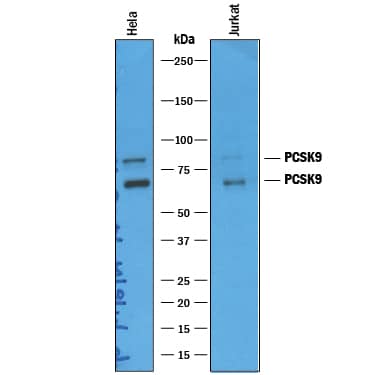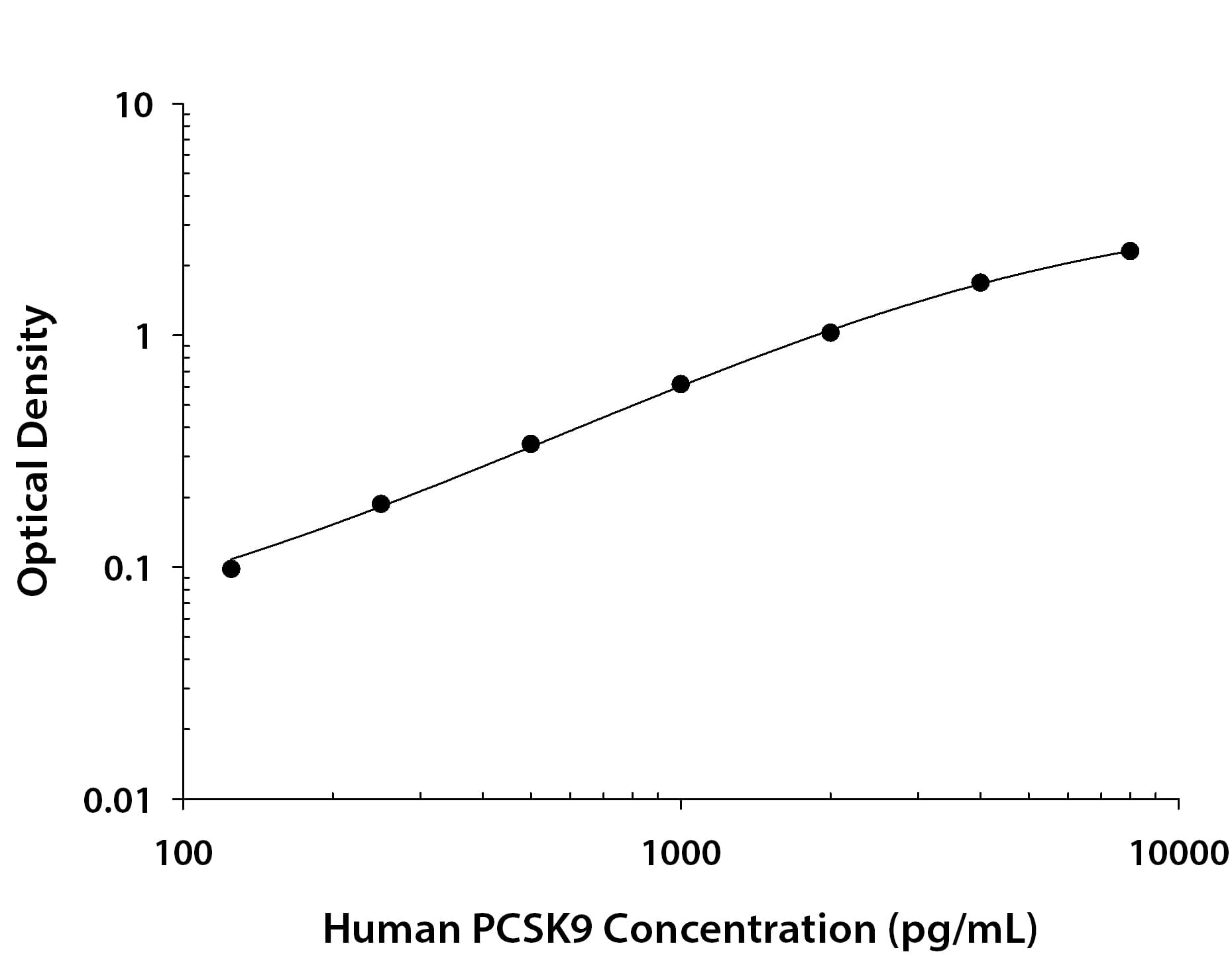Human Proprotein Convertase 9/PCSK9 Antibody
R&D Systems, part of Bio-Techne | Catalog # AF3888


Key Product Details
Species Reactivity
Validated:
Cited:
Applications
Validated:
Cited:
Label
Antibody Source
Product Specifications
Immunogen
Gln31-Gln692
Accession # Q8NBP7
Specificity
Clonality
Host
Isotype
Scientific Data Images for Human Proprotein Convertase 9/PCSK9 Antibody
Detection of Human Proprotein Convertase 9/PCSK9 by Western Blot.
Western blot shows lysates of HeLa human cervical epithelial carcinoma cell line and Jurkat human acute T cell leukemia cell line. PVDF membrane was probed with 1 µg/mL of Sheep Anti-Human Proprotein Convertase 9/PCSK9 Antigen Affinity-purified Polyclonal Antibody (Catalog # AF3888) followed by HRP-conjugated Anti-Sheep IgG Secondary Antibody (Catalog # HAF016). A specific band was detected for Pre-Proprotein Convertase 9/PCSK9 at approximately 80 kDa and mature Proprotein Convertase 9/PCSK9 60 kDa (as indicated). This experiment was conducted under reducing conditions and using Immunoblot Buffer Group 1.Human Proprotein Convertase 9/PCSK9 ELISA Standard Curve.
Recombinant Human Proprotein Convertase 9/PCSK9 protein was serially diluted 2-fold and captured by Rat Anti-Human Proprotein Convertase 9/PCSK9 Monoclonal Antibody (Catalog # MAB38883) coated on a Clear Polystyrene Microplate (Catalog # DY990). Sheep Anti-Human Proprotein Convertase 9/PCSK9 Antigen Affinity-purified Polyclonal Antibody (Catalog # AF3888) was biotinylated and incubated with the protein captured on the plate. Detection of the standard curve was achieved by incubating Streptavidin-HRP (Catalog # DY998) followed by Substrate Solution (Catalog # DY999) and stopping the enzymatic reaction with Stop Solution (Catalog # DY994).Applications for Human Proprotein Convertase 9/PCSK9 Antibody
ELISA
This antibody functions as an ELISA detection antibody when paired with Rat Anti-Human Proprotein Convertase 9/PCSK9 Monoclonal Antibody (Catalog # MAB38883).
This product is intended for assay development on various assay platforms requiring antibody pairs. We recommend the Human Proprotein Convertase 9/PCSK9 DuoSet ELISA Kit (Catalog # DY3888) for convenient development of a sandwich ELISA or the Human Proprotein Convertase 9/PCSK9 Quantikine ELISA Kit (Catalog # DPC900) for a complete optimized ELISA.
Immunoprecipitation
Sample: Conditioned cell culture medium spiked with Recombinant Human Proprotein Convertase 9/PCSK9 (Catalog # 3888-SE), see our available Western blot detection antibodies
Western Blot
Sample: HeLa human cervical epithelial carcinoma cell line and Jurkat human acute T cell leukemia cell line
Reviewed Applications
Read 6 reviews rated 4 using AF3888 in the following applications:
Formulation, Preparation, and Storage
Purification
Reconstitution
Formulation
Shipping
Stability & Storage
- 12 months from date of receipt, -20 to -70 °C as supplied.
- 1 month, 2 to 8 °C under sterile conditions after reconstitution.
- 6 months, -20 to -70 °C under sterile conditions after reconstitution.
Background: Proprotein Convertase 9/PCSK9
The human PCSK9 gene encodes Proprotein Convertase 9 (PC9), which is also known as Neural Apoptosis Regulated Convertase 1 (NARC1) (1). The deduced amino acid sequence of human PCSK9 consists of a signal peptide (residues 1-30), a pro peptide (residue 31-152), and a mature chain (residues 153-692) that contains a serine protease domain (residues 161-431) found in members of the furin/PC family. PCSK9 protease activity may be limited, since it has only been demonstrated through its own autocatalytic processing (2). After the autocleavage in the ER, the pro domain and mature chain exit the cell together through non-covalent interactions (3). PCSK9 is a key regulator of LDL-cholesterol levels (LDL-C) through binding of the LDL receptor, resulting in the reduction of receptor recycling to the cell surface and the acceleration of receptor degradation in lysosomes (3). Both gain of function (GOF) and loss-of-function (LOF) mutations have been found in the PCSK9 gene (3). GOF mutations are linked to familial autosomal dominant hypercholesterolemia, a disease characterized by elevated plasma levels of LDL-C. In comparison, LOF mutations lead to low levels of LDL-C and protection against coronary heart disease.
References
- Seidah, N.G. et al. (2003) Proc. Natl. Acad. Sci. USA 100:928.
- Naureckiene, S. et al. (2003) Arch. Biochem. Biophys. 420:55.
- Costet, P. et al. (2008) Trends Biochem. Sci. 33:426.
Alternate Names
Gene Symbol
UniProt
Additional Proprotein Convertase 9/PCSK9 Products
- All Products for Proprotein Convertase 9/PCSK9
- Proprotein Convertase 9/PCSK9 cDNA Clones
- Proprotein Convertase 9/PCSK9 ELISA Kits
- Proprotein Convertase 9/PCSK9 Lysates
- Proprotein Convertase 9/PCSK9 Primary Antibodies
- Proprotein Convertase 9/PCSK9 Proteins and Enzymes
- Proprotein Convertase 9/PCSK9 Simple Plex
Product Documents for Human Proprotein Convertase 9/PCSK9 Antibody
Product Specific Notices for Human Proprotein Convertase 9/PCSK9 Antibody
For research use only
